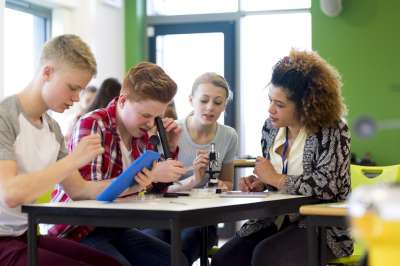How Can You Make It Happen?
When making comparisons, give students a graphic tool such as a Venn diagram or comparison chart to help them organize and record their thoughts. Model the use of the graphic organizer with the whole class prior to asking students to use it independently. For example, choose two characters in the same story to compare. Display an empty comparison chart on the overhead or board. With students, brainstorm key characteristics of the two different characters and record the characteristics in the appropriate areas of the chart. Students can then compare two other characters independently or in a small group and record their thoughts in their own comparison chart.
Another example is to have students list the characteristics of two or more things, recording the similarities and differences between each. For example, a comparison chart on three-dimensional geometric shapes could be used to organize the shapes by key features, such as the number of sides, edges, and vertices.
After students complete a graphic organizer, guide them toward the next step to deepen understanding. "What do we do with this information?" and "How does this help us to understand X?" are key questions that teachers need to encourage students to ask.
Have students take the information recorded in the graphic organizer and summarize or draw conclusions from it in writing. If students are comparing two animals in a comparison chart, for example, have them write a paragraph summarizing the similarities and differences and drawing conclusions based on their comparison.
How Can You Stretch Students' Thinking?
The following are some questions for students to consider when making comparisons:
How are two or more things or ideas the same?
How are they different?
Are the similarities of X and Y more important than their differences?
Do we learn something about X when we compare it to Y?
What is more difficult to understand about X when we compare it to Y?
Might a different comparison give us a different perspective?
When Can You Use It?
Reading/English
Compare characters from the same book or from different books. Explore the similarities and differences between two authors' writing styles. Compare various works of one author during an author study.
Writing
Compare two items or concepts using a comparison chart. Write a paragraph summarizing the similarities and differences and drawing conclusions based on the comparison.
Math
Sort shapes or pattern blocks, focusing on certain features, such as color and number of sides. Compare and organize three-dimensional figures, such as cones, cylinders, pyramids, and cubes. Comparisons can be made regarding shape of sides, number of sides, vertices, and edges.
Social Studies
Compare two different types of government, such as communism and democracy. Organize research notes on a country, comparing key features of the country to that of the United States. Choose two great figures from history and compare them. For primary students, compare the classroom community to their family.
Science
Compare two mammals, or explore the similarities and differences between mammals and reptiles. Analyze the similarities and differences between the states of matter: gas, liquid, and solid. Compare two or more biomes, such as forest, tundra, grassland, ocean, and desert.















